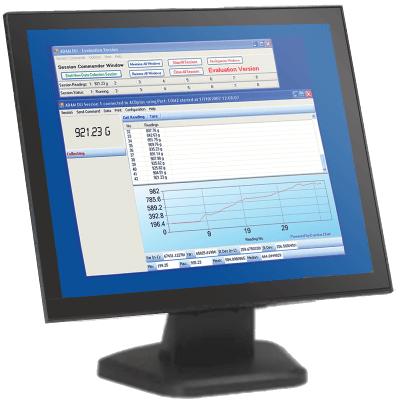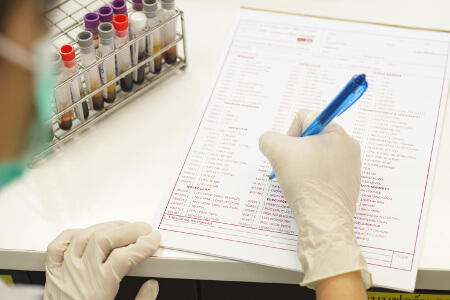
Managing data is vital in the lab industry. Improperly collected and stored data can be lost before analysis, recorded incorrectly, prevent work from being verified, or even impede the research and processes that need the data to advance. Good record keeping can help users track errors or refine an experiment. Records can be used to audit a lab or to check the data’s integrity. When using a lab balance, there are a few ways to collect and record data, which we’ll outline in this post. If you’re looking for information on data communication, you can read this blog post.
Laboratory Information Management System (LIMS)
LIMS is software designed to track, record and process a large amount of data. Scientists use it to track samples through various processes. It also provides a central location for all that data to make it more accessible, allowing transfer of data and results to other systems. LIMS often integrates with various instruments, such as lab balances, and some can even schedule analysis, monitor instruments, transfer results, and more. Not only can LIMS track information about the sample, but also about who processed which samples, when, where and how, and what happened to the sample during a process.
When integrated with lab balances, LIMS can allow users to use a computer to perform certain tasks with the balance and makes data collection quicker and easier.

Data storage & collection software
There are various types of software designed for data storage and data collection. Some are merely repositories into which data is entered, while others are highly automated and can communicate with various devices or convert and export data to other programs. Our own Adam DU software is specially designed to work with our balances and can quickly collect data from eight Adam balances simultaneously. Users can also export data in various formats, graph results and analyze them.
Printers for weighing scales & balances
In this age of cloud computing, you might wonder why people print results. But there are many reasons people still connect their balances to printers. Not every lab has access to LIMS, or they might choose to print data in addition to storing it digitally. Of course, technology can break, so some labs like having printed results as a backup. Data recording in the field can be difficult to accomplish digitally. Sometimes, data is sensitive and cannot be sent by email. Paper records can be easier to annotate, copy, and distribute depending on the lab. Results can also be printed to label samples.
Adam lab balances all include an RS-232 interface as a standard to connect to printers. Some of our balances also have a USB port. We sell both thermal and impact printers, and the printouts of our lab balances are all ISO and GLP compliant. This is very important: to comply with laboratory requirements, printouts must include specific information. It also makes data collection easier and reduces the potential for errors. For more information on GLP compliant printouts, check out this blog post.

Data loggers
A data logger is a compact device with interfaces (RS-232, USB or sometimes wireless) that allow it to be connected to various instruments in order to collect data and to transfer that data to a computer. It’s an easy way to collect data without having to manually write it down and transcribe it. They’re particularly useful on field measurements or if the balance cannot be connected to a computer (for example, if the balance is used to weigh chemicals or liquids that could damage a computer, or even if the workstations are too far apart and a cable would be impractical).
When getting a data logger, there are a few things to consider. Make sure the logger is compatible with your instruments, and that the data recorded outputs correctly and is compliant with your guidelines. A large memory can be helpful, as you won’t have to constantly erase records. Loggers can record a wide variety of data (such as temperature, humidity, date, time and much more) and some include an SD card.
Handwritten records
Sometimes, it’s easier to jot notes down on paper, or forms must be signed. Laboratories in schools and colleges tend to rely on handwritten records and usually dedicate a few classes on maintaining well-kept notes. Above all, the records should be neat and tidy, as easy to read as possible, and well-organized. Professors usually have standards for record keeping in their syllabus. In other labs, the organization will have guidelines on what is acceptable and what isn’t as far as collecting handwritten data. Many labs require that if notes are taken on loose leaf notebooks, the pages should be numbered. The entries should be recorded chronologically and dated. They’re frequently checked by a supervisor. It’s usually forbidden to tear pages or cross out mistakes (the error must be explained, and the correction clearly outlined), and work must be properly attributed.

The amount of data that you need to collect, store and analyze will have an impact on deciding which method is best for managing it. If the samples that you are weighing are not vital to an operation or do not need to be tracked, then you might only need temporary storage. However, if you’re in a food QC lab, you might find that your company may decide it needs to keep QC sample data for a long period of time and that the data should be regularly accessible. Other factors, like the importance of the data, the length of time you need to save and how often it needs to be accessed, will have an impact on how you collect and store it. In some cases, government regulations might dictate how the data is stored and saved (for example, medical data must be kept private, and valuable data is often encrypted).
Data collection and storage are essential for a properly functioning laboratory. There are various ways to make these processes quicker, easier, and less prone to errors. Correct data handling is integral and offers many benefits to a lab, from improving productivity to boosting credibility. Adam Equipment designs lab balances to help you manage data efficiently, consistently, and within industry guidelines


